



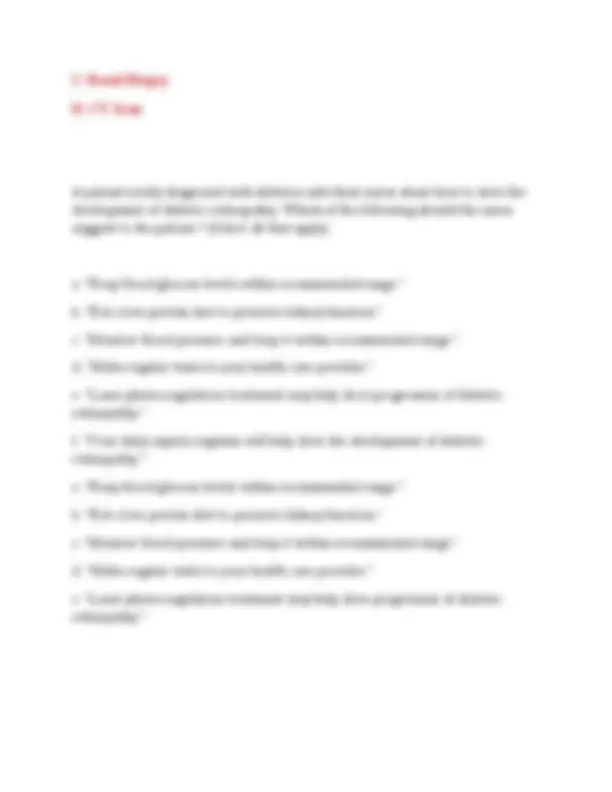





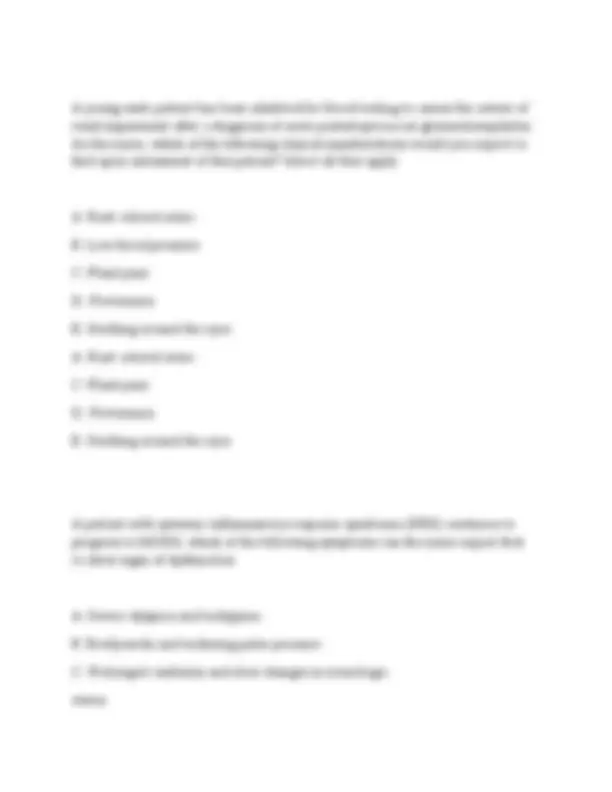




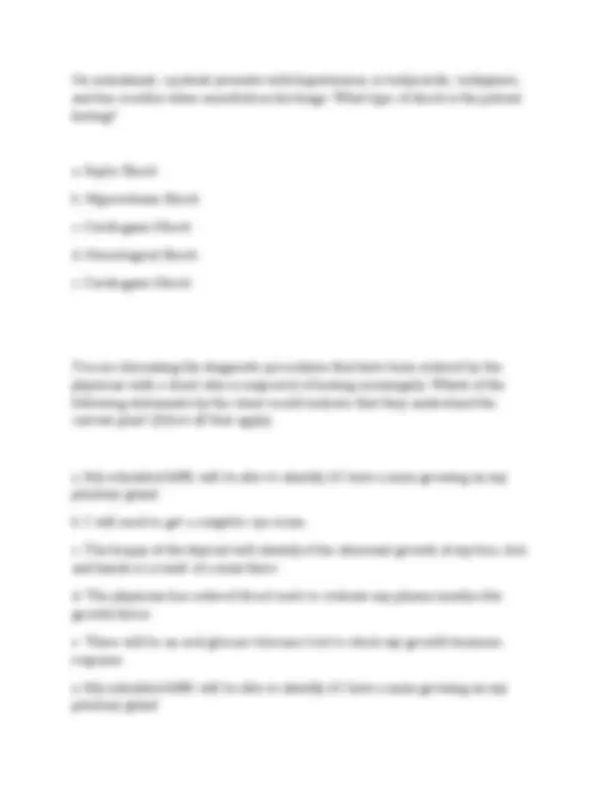



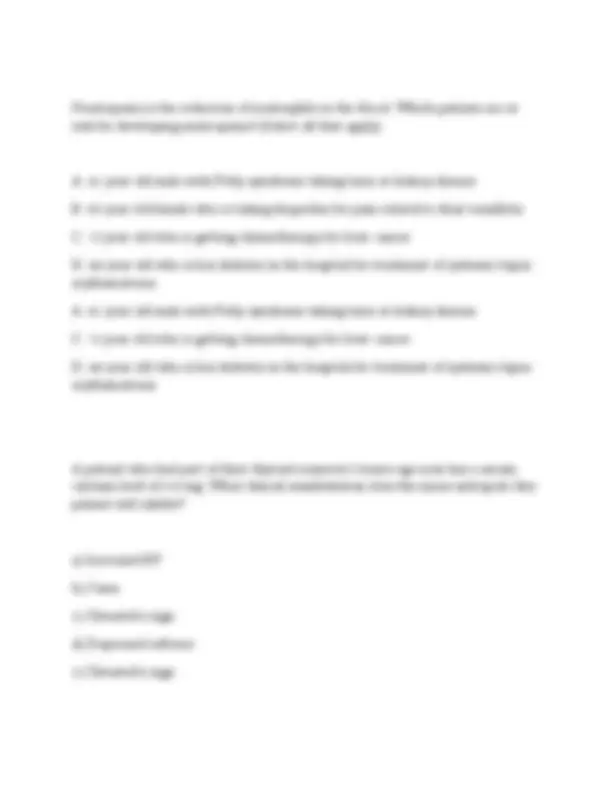
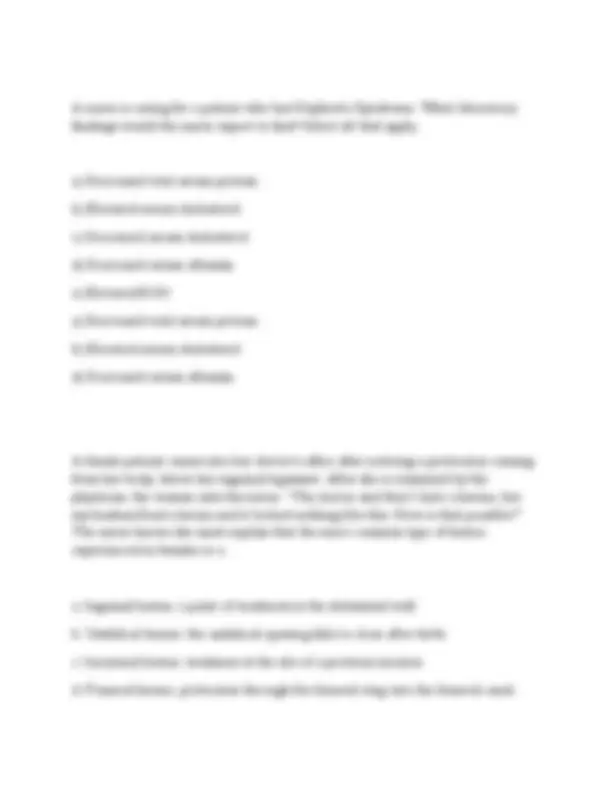






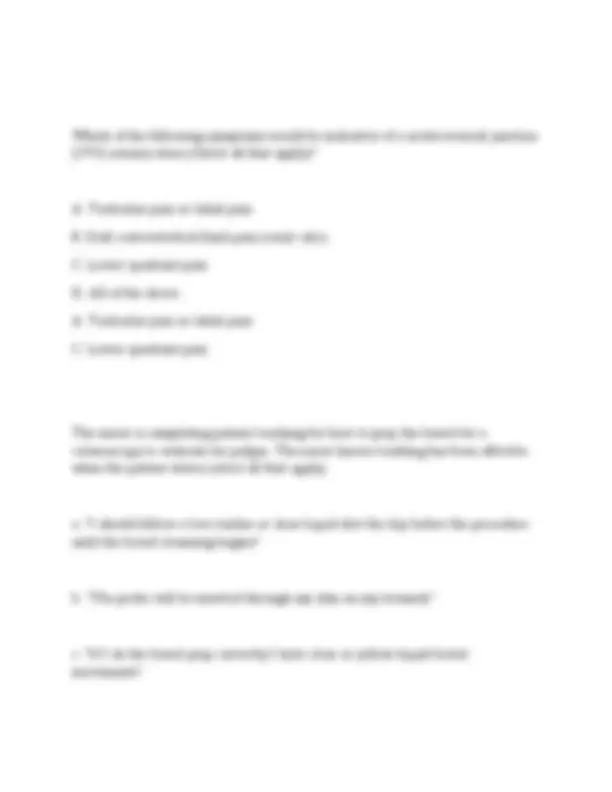











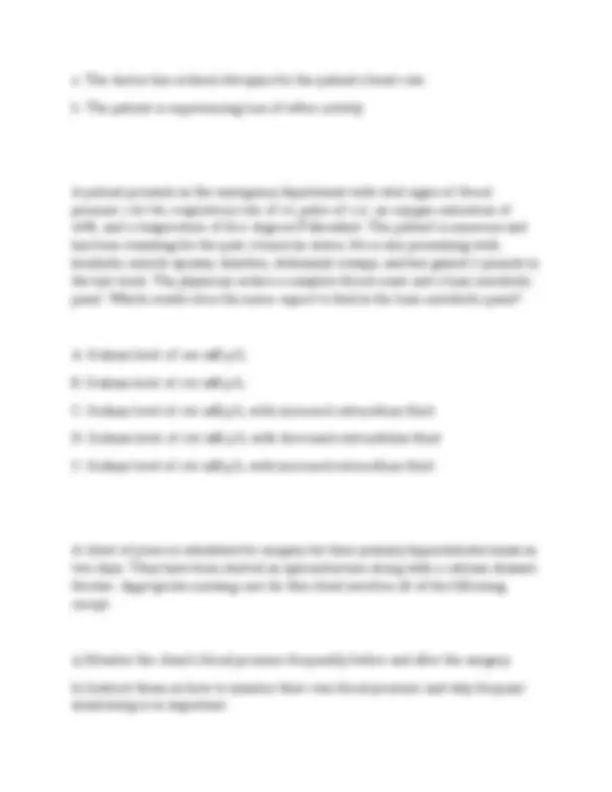

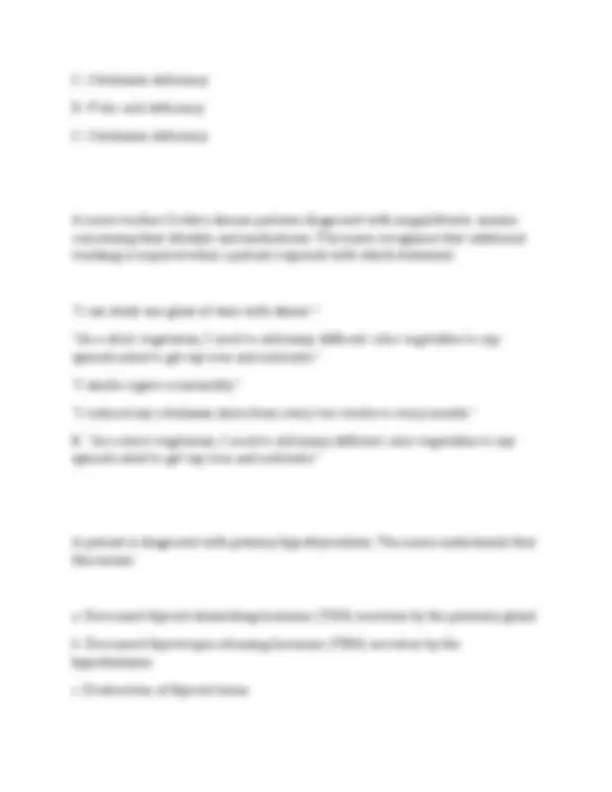



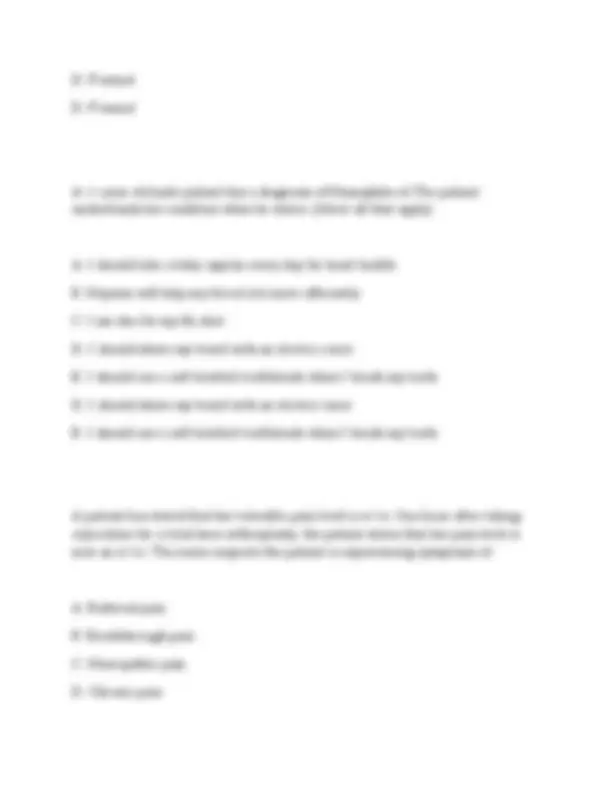


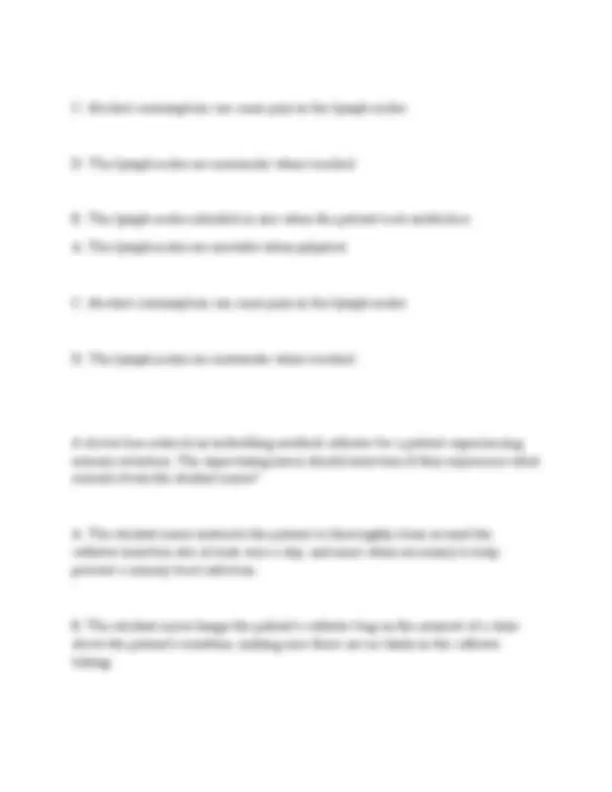








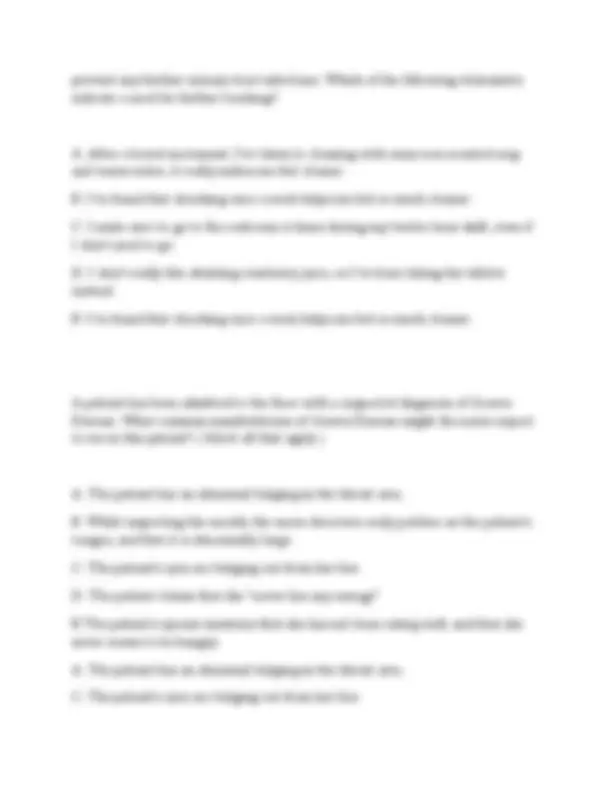

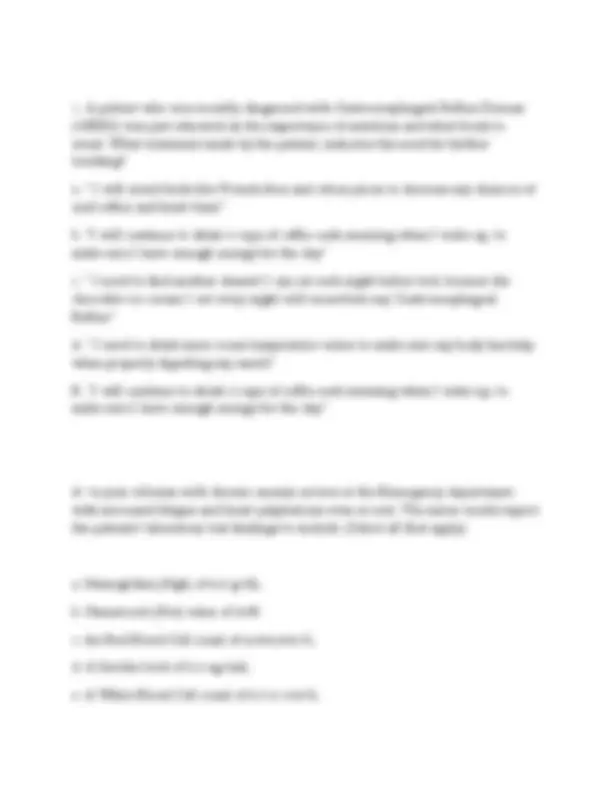



Study with the several resources on Docsity

Earn points by helping other students or get them with a premium plan


Prepare for your exams
Study with the several resources on Docsity

Earn points to download
Earn points by helping other students or get them with a premium plan
Community
Ask the community for help and clear up your study doubts
Discover the best universities in your country according to Docsity users
Free resources
Download our free guides on studying techniques, anxiety management strategies, and thesis advice from Docsity tutors
2025-2026 NCLEX MED/SURG FINAL EXAM|ACTUAL 120 QUESTIONS AND ANSWERS|ALREADY GRADED A+
Typology: Exams
1 / 68

This page cannot be seen from the preview
Don't miss anything!





























































A student nurse is explaining the risk factors for metabolic syndrome which statement by the student would require correction from the nurse? A. Waist circumference of 41 for a male B. Body mass index of 30 or higher C. Triglycerides level of 130 D. Blood Glucose of 168 C. Triglycerides level of 130 A 68 year-old male suffering from chronic diarrhea is found to have a serum phosphate level of 0.9 mg/dL. After reviewing this lab value the nurse can expect the patient to exhibit which of the following symptoms? (Select all that apply) A. Confusion B. Numbness/tingling in extremities C. Muscle weakness D. Cardiac dysrhythmias E. Dry mucous membranes A. Confusion C. Muscle weakness D. Cardiac dysrhythmias
The physician orders an arterial blood gas who is hyperventilating. The nurse can anticipate that the blood gas results will most likely reveal that the patient is in: A. Metabolic alkalosis B. Respiratory acidosis C. Metabolic acidosis D. Respiratory alkalosis D. Respiratory alkalosis Thalassemia is a group of diseases that causes an inadequate amount of normal hemoglobin to be produced in the body. Thalassemia minor is usually asymptomatic and requires no treatments. There is no cure for thalassemia major, however, there are therapies available to help manage the disease. These include: A. Blood transfusions B. Subcutaneous or IV deferoxamine C. Iron supplements D. Zinc supplements E. Splenectomy A. Blood transfusions B. Subcutaneous or IV deferoxamine D. Zinc supplements E. Splenectomy
B. Normal Body Mass Index C. Prolonged constipation D. Straining in an effort to defecate E. Heavy lifting F. Standing or sitting for a long period of time A. Pregnancy B. Normal Body Mass Index C. Prolonged constipation D. Straining in an effort to defecate E. Heavy lifting F. Standing or sitting for a long period of time The most common cause of cobalamin deficiency is pernicious anemia. Which of the following patients may develop a cobalamin deficiency? (Select all that apply) A. A 36-year-old morbidity obese patient that recently had the Roux-en-Y Gastric Bypass (RYGB) Surgery B. A 45-year-old male construction working who has a history of smoking two packs of cigarettes a day C. A 23-year-old female nurse apprentice who is having a routine colonoscopy D. A 50-year-old male yoga instructor who is on a strict vegetarian diet E. A 28-year-old female nursing student taking Pepcid and Omeprazole to control a Pepcid ulcer for the past three years A. A 36-year-old morbidity obese patient that recently had the Roux-en-Y Gastric Bypass (RYGB) Surgery
B. A 45-year-old male construction working who has a history of smoking two packs of cigarettes a day D. A 50-year-old male yoga instructor who is on a strict vegetarian diet E. A 28-year-old female nursing student taking Pepcid and Omeprazole to control a Pepcid ulcer for the past three years A 25 year old female patient is diagnosed with viral hepatitis. The provider prescribes Ribavirin, before administering the nucleoside what test will the nurse give to the patient? a). Liver function test b). Pregnancy test c). Occult blood test d). Urinalysis b). Pregnancy test A Roux-en-Y Gastric Bypass (RYGB) Surgical patient is suffering from an early case of iron deficiency. Which of the following group of clinical manifestations will the patient present? A. No Symptoms B. Anorexia, Abdominal Pain, Paresthesia of the hands and feet, Nausea, Red and Beefy Tongue C. Pallor, Glossitis, Headache, and Burning Sensation of the Tongue
A 27-year-old female patient presents to the ICU after a severe thoracic burn injury. She presents with the following vitals: BP of 90/67, HR of 135, temperature of 100.1, and respiratory rate of 24. She is unconscious, unresponsive, and has purpura present on both lower calves. It's suspected this patient is experiencing DIC as a result of hypovolemic shock. Which of the orders should the nurse QUESTION from the physician? A. IV bolus of NS 0.9% B. Administer STAT order of RBC's C. 500 units of IV heparin D. Administer STAT oral anticoagulants D. Administer STAT oral anticoagulants A patient diagnosed with systemic lupus erythematosus presents to the healthcare provider for a routine checkup. A urinalysis is completed and has noted proteinuria and hematuria. Which of the following diagnostic studies could be performed to confirm a diagnosis of chronic glomerulonephritis? (select all that apply) A. MRI B. Ultrasound C. Renal Biopsy D. CT Scan E. EKG B. Ultrasound
C. Renal Biopsy D. CT Scan A patient newly diagnosed with diabetes asks their nurse about how to slow the development of diabetic retinopathy. Which of the following should the nurse suggest to the patient? (Select all that apply) a. "Keep blood glucose levels within recommended range." b. "Eat a low protein diet to preserve kidney function." c. "Monitor blood pressure and keep it within recommended range." d. "Make regular visits to your health care provider." e. "Laser photocoagulation treatment may help slow progression of diabetic retinopathy." f. "Your daily aspirin regimen will help slow the development of diabetic retinopathy." a. "Keep blood glucose levels within recommended range." b. "Eat a low protein diet to preserve kidney function." c. "Monitor blood pressure and keep it within recommended range." d. "Make regular visits to your health care provider." e. "Laser photocoagulation treatment may help slow progression of diabetic retinopathy."
A. The nurse checks the patient's blood glucose level and notices it's on the higher end of normal. She injects insulin into the parenteral nutrition bag to prevent hyperglycemia. C. The floor is running low on pumps. The nurse sets the parenteral nutrition bag up by drip rate. A patient with chronic hyperkalemia has a basic metabolic panel that came back with an abnormality of potassium of 7.5 mEq/L. While working alongside a nursing student giving care to the patient after this finding, the nurse will intervene if the nursing student does which action: (Select all that apply) A. Allows the patient to enjoy a meal brought by a family member with salmon, sweet potato fries, and a spinach salad B. Administers loop diuretics C. Administers Kayexalate orally D. Gives Veltassa at 0900 with other 0900 medications E. Continuously monitors ECG B. Administers loop diuretics D. Gives Veltassa at 0900 with other 0900 medications A nurse has a 25-year-old patient, diagnosed with anorexia, started on enteral nutrition through a nasogastric tube. Which observation by the nurse would warrant immediate action?
A. High blood glucose level B. Slight redness around the nostril C. Gastric residual volume 400mL D. Patient's head of bed at 30 degrees A. High blood glucose level A patient with gastric cancer has undergone a total gastrectomy. You are caring for the patient postoperatively. Which statement if made by the patient determines need for further patient education? A. "I will have the NG tube removed as soon as my gut peristalsis returns" B. "I may experience weight loss" C. "I will need to take vitamins to help with my nutritional intake" D. "I should expect a large quantity of secretions in my NG tube canister" D. The NG tube does not drain a large quantity of secretions because removal of the stomach has eliminated the reservoir capacity (p. 921). (Lewis et al., pg. 921). The nurse comes in on shift change and needs to see all the patients who have the greatest risk of getting esophageal cancer because of how fast it spreads to the liver and lungs via lymph system. What patients should the nurse be most concerned about? Select all that apply A. 58-year old who has a history of tachycardia and obesity but manages her diet and does morning yoga.
Tina is a 70-year-old female from Austin, Texas who works at her favorite restaurant, Kentucky Fried Chicken (KFC) part time. During her annual physical, she claims to only smoke one pack of cigarettes per week and drinks a glass of wine with dinner. She stated that she became a vegetarian for her New Year's resolution one year ago. She was diagnosed with lymphoma 3 years ago and has recently stopped with treatments. Her favorite snacks are nuts and seeds. What are her risk factors for developing Diverticulitis, which is "inflammation of one or more diverticula, resulting in perforation into the peritoneum?" Select all that apply: A. Being over the age of 55 years' old B. Smoking 1 pack per week C. Drinking 1 glass of wine daily D. Being a vegetarian E. Having lymphoma F. Consumption of nuts and seeds B. Smoking 1 pack per week E. Having lymphoma When providing discharge instructions to a patient newly diagnosed with sickle cell disease, it is important to mention that they should seek early medical attention for upper respiratory infections or else they may experience which of the following symptoms?
A. Shock, hypoxia, and body pain. B. Sore throat, fever, and swollen lymph nodes. C. Hyponatremia, hyperkalemia, and dehydration. D. Fever, chills, nausea, and swollen lymph nodes. A. Shock, hypoxia, and body pain. A 35-year old female patient comes into the clinic with a new diagnosis of Addison's disease. After providing education to the patient about this disease, the nurse knows further teaching is required when the patient states which of the following? A. "I will need to increase my hydrocortisone dosage during a stressful event such as surgery or if I contract an infection." B. "Once my hormone levels stabilize my doctor can start lowering my dose and eventually I'll be able to stop taking hormone therapy." C. "I'm glad to know I can have a normal life expectancy as long as I follow my medication regimen." D. "It's best to take my mineralocorticoids in the morning." B. "Once my hormone levels stabilize my doctor can start lowering my dose and eventually I'll be able to stop taking hormone therapy." A nurse is assessing a 25-year old female patient who underwent subtotal thyroidectomy 4 hours ago for any signs of complications. The nurse knows immediate action is needed if the patient exhibits which of the following symptoms (Select all that apply)?
E. GI bleeding All of the following patients must be closely monitored following a kidney transplantation due to an increased risk of complications EXCEPT: A. A patient who is morbidly obese. B. A patient with cardiovascular disease. C. A patient with hepatitis C. D. A patient who smokes. C. A patient with hepatitis C. A male patient who has been receiving prolonged high-dose antibiotics has developed pearly, bluish white "milk-curd" membranous lesions on the inside of his mouth. The nurse anticipates a diagnosis of which of the following? A. Oral candidiasis B. Vincent's infection C. Herpes D. Gingivitis A. Oral candidiasis
A patient is preparing to take a capsule endoscopy for suspected Crohn's disease. The nurse is doing pre-op teaching with the patient. Which statement would the nurse need to correct if stated by the patient? a. "I will not eat food the evening before the pill." b. "I understand that I can have water two hours after I swallow the pill" c. "I will have to wait at least a day before coming back to get this pill out of me." d. "If I have a narrowed bowel, I may need to use a patency pill before this procedure." c. "I will have to wait at least a day before coming back to get this pill out of me." A patient is presenting with a heart rate of 45 beats per minute, a capillary return greater than two seconds, and cool skin temperature. The nurse suspects neurogenic shock. Which medications does the nurse prepare to administer? (Select all that apply) a. Phenylephrine b. Atropine c. Furosemide d. Clindamycin e. Epinephrine a. Phenylephrine b. Atropine
D. Hypoglycemia E. Decreased bleeding time and increased platelet count A. Severe dyspnea and tachypnea A 39-year-old pregnant female patient presents symptoms of dysuria, urgency, and frequency, which additional symptoms, diagnostic studies, and treatments would be associated with acute pyelonephritis versus cystitis? A. Flank pain, chills, and fever B. Antibiotics for 3 days C. Urine cultures D. Sensitivity guided antibiotic therapy E. Symptoms generally improve after 1-2 days of therapy A. Flank pain, chills, and fever C. Urine cultures D. Sensitivity guided antibiotic therapy The patient is experiencing the following symptoms: shakiness, palpitations, nervousness, diaphoresis, anxiety, hunger, pallor, difficulty speaking, visual disturbances, stupor, and confusion. As a nurse, you anticipate which treatment to be prescribed? (multiple choice). a. A consult with the psychologist. The patient is experiencing an anxiety attack.
b. Fluids, careful observation, and possible sedation. Patient is experiencing alcohol intoxication. c. An order to check the blood glucose and immediately administer insulin intravenously if the reading is greater than 250 mg/dL. The patient is experiencing diabetic ketoacidosis. d. An order to check the blood glucose and give 4-6 ounces of fruit juice if the reading is less than 70 mg/dL. The patient is experiencing hypoglycemia. d. An order to check the blood glucose and give 4-6 ounces of fruit juice if the reading is less than 70 mg/dL. The patient is experiencing hypoglycemia. The nurse identifies which of the following patients as the highest risk for developing cirrhosis? A. A 58-year-old African American male with Hepatitis C who also has a 40-year history of alcohol and drug abuse. B. A 23-year-old female who drinks a few glasses of wine each night with dinner. C. A 41-year-old male with a BMI of 46 who takes 1,000 mg of acetaminophen daily to control headaches. D. A 70-year-old female with malabsorption syndrome who also has a history of alcoholism, but has been sober for 30 years. A. A 58-year-old African American male with Hepatitis C who also has a 40-year history of alcohol and drug abuse. A patient's test results reveal an Impaired Fasting Glucose (IFG) of 120mg/dL. The patient states they are feeling fine, and have no symptoms of Diabetes